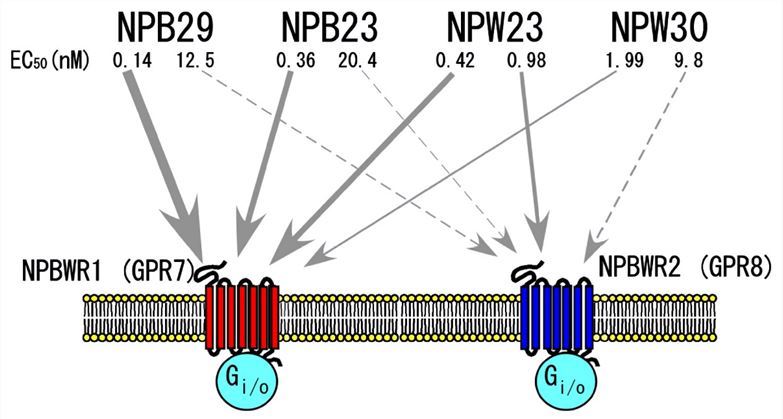Introduction of NPBWR2
Encoded by NPBWR2 gene which is located on chromosome 20q13.3 in human, neuropeptide B/W receptor-2 (NPBWR1) has been known as orphan receptor GPR8. Human NPBWR2 has 333 amino acid residues and presents approximately 64% sequence homology with NPBWR1. In general, both NPW and NPB bind and activate NPBWR2 with varying degrees of affinity. Compared with NPBWR1, the potency rank order of NPBWR2 is NPW23 > NPW30 > NPB. The recent research showed that high expression of NPBWR2 mRNA has been found in the human hippocampus and amygdala, whereas it has not been found in rodents.
| Basic Information of NPBWR2 | |
| Protein Name | Neuropeptides B/W receptor type 2 |
| Gene Name | NPBWR2 |
| Aliases | GPR8 |
| Organism | Homo sapiens (Human) |
| UniProt ID | P48146 |
| Transmembrane Times | 7 |
| Length (aa) | 333 |
| Sequence | MQAAGHPEPLDSRGSFSLPTMGANVSQDNGTGHNATFSEPLPFLYVLLPAVYSGICAVGLTGNTAVILVILRAPKMKTVTNVFILNLAVADGLFTLVLPVNIAEHLLQYWPFGELLCKLVLAVDHYNIFSSIYFLAVMSVDRYLVVLATVRSRHMPWRTYRGAKVASLCVWLGVTVLVLPFFSFAGVYSNELQVPSCGLSFPWPEQVWFKASRVYTLVLGFVLPVCTICVLYTDLLRRLRAVRLRSGAKALGKARRKVTVLVLVVLAVCLLCWTPFHLASVVALTTDLPQTPLVISMSYVITSLSYANSCLNPFLYAFLDDNFRKNFRSILRC |
Function of NPBWR2 Membrane Protein
Neuropeptide B (NPB) and neuropeptide W (NPW) are two endogenous peptide ligands of NPBWR2. In recent years, many studies have shown that NPB/W system is associated with the modulation of inflammatory pain. Due to the physiological role of NPB in pain regulation, the agonists for NPBWR2 present great potential for the treatment of chronic inflammatory pain. The binding of NPBWR2 to Gi-class of G-proteins suggests the inhibitory properties of these neuropeptides on neurons according to the activation of GIRK. It is worth mentioning that NPW is released from the hypothalamus and acts on adenohypophyseal cells via NPBWR2. In contrast, the effects of NPB and NPW might be mediated by the high expression of NPBWR1 in the hypothalamus.
 Fig.1 Structure of NPB/W and their receptors.
Fig.1 Structure of NPB/W and their receptors.
Application of NPBWR2 Membrane Protein in Literature
NPB is an endogenous ligand for the orphan G protein-coupled receptors NPBWR1 and NPBWR2. This article reports the important roles of NPB/NPBWR1 or NPBWR2 system in modulating the reproductive activity in the pig.
NPB and NPW are two endogenous neuropeptide ligands for the G protein-coupled receptors NPBWR1 and NPBWR2. This article reveals the critical roles of NPW/NPBWR1 system in the gating of stressful stimuli during exposure to novel environments.
Authors in this group perform a series of studies characterizing the NPB and NPW and their receptors in chickens, geese, mammals, and vertebrates. Finally, they get the conclusion that NPW might be a novel inhibitory hypophysiotropic or releasing factor.
This article reports that NPB and NPW are associated with the regulation of energy homeostasis, feeding behavior, neuroendocrine function, and modulating inflammatory pain. The recent studies also support their potential applications in regulating stress responses, emotion, anxiety, and fear.
NPW has been identified as the endogenous ligand for both NPBWR1 and NPBWR2. This article reveals the distribution of NPW and the neuronal interactions between NPW. In addition, the dichotomous actions of NPW have also been discussed.
NPBWR2 Preparation Options
In order to obtain the soluble and functional target protein, the versatile Magic™ membrane protein production platform in Creative Biolabs enables many flexible options, from which you can always find a better match for your particular project. Aided by our versatile Magic™ anti-membrane protein antibody discovery platform, we also provide customized anti-NPBWR2 antibody development services.
As a pioneer and the undisputed global leader in the field of membrane protein preparation, Creative Biolabs offers the most comprehensive membrane protein services. Our various strategies can be tailor-designed to meet your specific needs. If you are interested in our services, please do not hesitate to contact us for more information.
All listed services and products are For Research Use Only. Do Not use in any diagnostic or therapeutic applications.